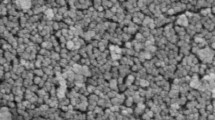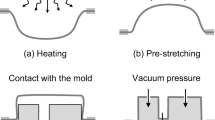Abstract
Processing conditions must be rigorously controlled in the production of fabric softener because mechanical energy input during the mixing operation may provoke undesirable structural transitions. Hence, ability to control and modify rheological properties of surfactant systems is an important pre-requisite for many applications of surfactant formulations. Mixtures of a commercial cationic esterquat-type surfactant and different concentrations of salt (CaCl2) were rheologically and microscopically characterized. Shear-induced microstructural transitions have been studied in order to control the formation of vesicles, which is undesirable. The addition of salt allows viscosity to be adjusted and provoked a lack of viscoelastic properties. In addition, a shear thickening effect above a specific value of critical shear rate, which is different for each salt concentration, was observed. This is related to the transition from lamellar bilayer to vesicles. This fact was confirmed by hysteresis-loop experiments, which showed apparent antithixotropic behaviour. Start-up flow tests indicated that a minimum value for shear rate and a certain shear time are needed for the formation of shear-induced structures. After this test, the systems showed viscoelastic properties due to the formation of vesicles.









Similar content being viewed by others
References
Schindler WD, Hauser PJ (2000) Chemical finishing of textile. Woodhead Publishing, Cambridge
Ponsati O (1992) In: Jorn Com Esp Deterg. Vol 23, Comité Español de la Detergencia, Tensioactivos y Afines, Barcelona, 167–180
Pi R, Bonastre N, Copete T, Prat E (1997) In: JornCom Esp Deterg. Vol 27, Comité Español de la Detergencia Tensioactivos y Afines, Barcelona, 257–268
Mishra S, Tyagi VK (2007) Esterquats: the novel class of cationic fabric softeners. J Oleo Sci 56:269–276. doi:10.5650/jos.56.269
Reif I, Mulqueen M, Blankschtein D (2001) Molecular-thermodynamic prediction of critical micelle concentrations of commercial surfactants. Langmuir 17:5801–5812. doi:10.1021/la0105578
Abe M (2014) Mixed surfactant system, vol 124. CRC Press, Boca Raton
Berret JF, Gamez-Corrales R, Lerouge S, Decruppe JP (2000) Shear-thickening transition in surfactant solutions: new experimental features from rheology and flow birefringence. Eur Phys J E Soft Matter Biol Phys 2:343–350. doi:10.1007/s101890050016
Lu B, Zheng Y, Davis HT, Scriven LE, Talmon Y, Zakin JL (1998) Effect of variations in counterion to surfactant ratio on rheology and microstructures of drag reducing cationic surfactant systems. Rheol Acta 37:528–548. doi:10.1007/s003970050140
Bergins C, Nowak M, Urban M (2001) The flow of a dilute cationic surfactant solution past a circular cylinder. Exp Fluids 30:410–417. doi:10.1007/s003480000218
Haas S, Hoffmann H, Thunig C, Hoinkis E (1999) Phase and aggregation behaviour of double-chain cationic surfactants from the class of N-alkyl-N-alkyl′-N, N-dimethylammonium bromide surfactants. Colloid Polym Sci 277:856–867. doi:10.1007/s003960050462
Partal P, Kowalski AJ, Machin D, Kiratzis N, Berni MG, Lawrence CJ (2001) Rheology and microstructural transitions in the lamellar phase of a cationic surfactant. Langmuir 17:1331–1337. doi:10.1021/la0007731
Medronho B, Shafaei S, Szopko R, Miguel MG, Olsson U, Schmidt C (2008) Shear-induced transitions between a planar lamellar phase and multilamellar vesicles: continuous versus discontinuous transformation. Langmuir 24:6480–6486. doi:10.1021/la800326a
Medronho B, Miguel MG, Olsson U (2007) Viscoelasticity of a nonionic lamellar phase. Langmuir 23:5270–5274. doi:10.1021/la063599a
Kinzel S, Gradzielski M (2008) Control of phase behavior and properties of vesicle gels by admixing ionic surfactants to the nonionic surfactant Brij 30. Langmuir 24:10123–10132. doi:10.1021/la801452z
Yan Y, Xiong W, Li X, Lu T, Huang J, Li Z, Fu H (2007) Molecular packing parameter in bolaamphiphile solutions: adjustment of aggregate morphology by modifying the solution conditions. J Phys Chem B 111:2225–2230. doi:10.1021/jp065235x
Showell M (2005) Handbook of detergents, part D: formulation, vol 128. CRC Press, Boca Ratón
Zoller U (2008) Handbook of detergents, part E: applications, vol 141. CRC Press, Boca Ratón
Smulders E (2002) Laundry detergents. Wiley, New York
Calero N, Alfaro MC, Lluch MA, Berjano M, Muñoz J (2010) Rheological behavior and structure of a commercial esterquat surfactant aqueous system. Chem Eng Tech 33:481–488. doi:10.1002/ceat.200900496
Mezger TG (2006) The rheology handbook: for users of rotational and oscillatory rheometers, 2nd edn. Vincentz Network GmbH & Co KG, Hannover
Hoffman H (1994) Structure and flow in surfactant solutions. ACS Symp Ser 578:2–31
Leon A, Bonn D, Meunier J, Al-Kahwaji A, Greffier O, Kellay H (2000) Coupling between flow and structure for a lamellar surfactant phase. Phys Rev Lett 84:1335–1338. doi:10.1103/PhysRevLett.84.1335
Kawabata Y, Ichiguchi K, Ando T, Kato T (2014) Vesicle formations at critical vesicle concentration in a polyoxyethylene type nonionic surfactant system. Colloids Surf A 462:179–185. doi:10.1016/j.colsurfa.2014.09.009
Bergenholtz J, Wagner NJ (1996) Formation of AOT/brine multilamellar vesicles. Langmuir 12:3122–3126. doi:10.1021/la950696n
Schmidt G, Müller S, Schmidt C, Richtering W (1998) Rheo-optical investigations of lyotropic mesophases of polymeric surfactants. Rheol Acta 38:486–494. doi:10.1007/s003970050201
Zipfel J, Berghausen J, Lindner P, Richtering WJ (1999) Influence of shear on lyotropic lamellar phases with different membrane defects. J Phys Chem B 103:284–2849. doi:10.1021/jp983917h
Bergmeier M, Gradzielski M, Hoffmann H, Mortensen KJ (1999) Behavior of ionically charged lamellar systems under the influence of a shear field. J Phys Chem B 103:1605–1917. doi:10.1021/jp983480d
Calero N, Sanromán M, Muñoz J, Berjano M (2006) In: JornCom Esp Deterg. Comité Español de la Detergencia Tensioactivos y Afines, Barcelona 36: 255–266
Nan YQ, He SQ, Liu MN, He HY, Hao LS (2013) The influence of inorganic salts on the rheological properties of 1,3-propanediyl bis(dodecyl dimethylammonium bromide) and sodium dodecylsulfonate aqueous mixed system. Colloid Surf A 436:158–169. doi:10.1016/j.colsurfa.2013.06.032
Oswald P, Allain M (1988) Rheology an structural defects in a lyotropic lamellar phase. J Colloid Interf Sci 126(1):45–53. doi:10.1016/0021-9797(88)90097-5
Tuan NA, Mizunuma H (2013) Advection of shear-induced surfactant threads and turbulent drag reduction. J Rheol 57:1819–1832. doi:10.1122/1.4826543
Manosroi A, Wongtrakul P, Manosroi J, Sakai H, Sugawara F, Yuasa M, Abe M (2003) Characterization of vesicles prepared with various non-ionic surfactants mixed with cholesterol. Colloids Surf B 30:129–138. doi:10.1016/S0927-7765(03)00080-8
Medronho B, Fujii S, Richtering W, Miguel MG, Olsson U (2005) Reversible size of shear-induced multi-lamellar vesicles. Colloid Polym Sci 284:317–321. doi:10.1007/s00396-005-1367-5
Goldszal A, Jamieson AM, Mann JA Jr, Polak J, Rosenblatt C (1996) Rheology, optical microscopy, and electron microscopy of cationic surfactant gels. J Colloid Interf Sci 180:261–268. doi:10.1006/jcis.1996.0298
Barnes HA (1997) Thixotropy—a review. J Non-Newton Fluid 70:1–33. doi:10.1016/S0377-0257(97)00004-9
Yuan Z, Hao J, Hoffmann H (2006) A promising system of mixed single- and double-short-tailed PEO ether phosphate esters: phase behavior and vesicle formation. J Colloid Interface Sci 302:673–681. doi:10.1016/j.jcis.2006.06.059
Acknowledgments
This work was conducted within the frame of the “Cátedra de Detergencia” of the University of Seville, sponsored by PERSAN, S.A. The authors are grateful for the support received.
Author information
Authors and Affiliations
Corresponding author
About this article
Cite this article
Calero, N., Santos, J., Berjano, M. et al. Shear-Induced Structural Transitions in a Model Fabric Softener Containing an Esterquat Surfactant. J Surfact Deterg 19, 609–617 (2016). https://doi.org/10.1007/s11743-016-1808-9
Received:
Accepted:
Published:
Issue Date:
DOI: https://doi.org/10.1007/s11743-016-1808-9




